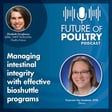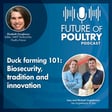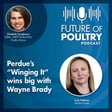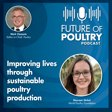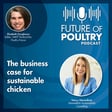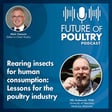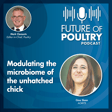Become a Creator today!Start creating today - Share your story with the world!
Start for free
00:00:00
00:00:01

How laser technology can keep wild birds away from poultry farms
Mélina Gourvennec, marketing manager with AgriProTech, discusses the role that laser technology can play in enhancing farm biosecurity.
Transcript
Introduction to the Future of Poultry Podcast Series
00:00:00
Speaker
Hello and welcome to the Future of Poultry podcast series.
00:00:12
Speaker
I'm Mark Clemens, Editor-in-Chief Poultry with Watt Global Media.
Biosecurity Tools to Protect Poultry
00:00:16
Speaker
And today we're going to talk about a new biosecurity tool that keeps wild birds away from the farm. Disease can be transmitted to poultry flocks both through direct and indirect contact with wild birds. So you need to keep them away, not only from the poultry house, but also areas nearby that they may find attractive.
00:00:38
Speaker
for example silos or other storage areas. I've been fortunate enough to see a new way of doing just that, the laser track LTZ-1000, designed by Agra Protec and described as an autonomous and intelligent scarer.
Introducing the LTZ-1000 Bird Repellent
00:00:56
Speaker
Agra Protec operates out of Brittany, one of France's major poultry producing regions. LTZ-1000 won two stars in the 2024 Inn of Spass Awards, held at agricultural trade show Spass, where I was lucky to first learn about it from marketing manager with Agroprotec, Melana Gorinick. And I'm delighted to have Melana here with us today.
Interview with Melana Gorinick from Agra Protec
00:01:21
Speaker
So hello, Melana. Thank you for joining us. Perhaps we could start. Could you tell me, laser track LTZ1000, what exactly is it? And
00:01:32
Speaker
How was it developed? The laser track LZ-2000 is a smart bird repellent system. It has been developed, as you say, by the company Agribrotec and we have been actually working with laser technology for for many years and at first all we bought laser repellers from other companies and at some point we wanted to be able to develop our own laser system Because we really trust that technology, the laser technology, we have found that it is very highly ah efficient as a bird repeller.
Effectiveness and Setup of the LTZ-1000
00:02:10
Speaker
And the the great advantage is that there is no habituation effect on the birds or very low habituation effect. And it is completely silent. So we have decided to design and create our own laser repeller to be sure that we can control quality.
00:02:29
Speaker
And we've been working quite hard on this LZ-2000 laser track for thirty for several years now. When I saw a laser track in space, the laser's green. Why would you have a green laser?
00:02:42
Speaker
green color has been chosen because it is the most effective color at deterring birds because it is the brightest light in the visible light spectrum. So the green dot is very important in the rebelling effect because this is the vision of the green dot that scares the birds away. So it has to be highly visible from the birds And this is the the brightest color. So the device is autonomous. Once a producer has it installed, what would he or she need to do to make it work? After the installation of the system, a member of the team of Agri-Protect comes to carry out the initial commissioning. This means that the system is being programmed and
00:03:30
Speaker
And we brief the operator to use it safely. We explain him how to use it, how to use it, and how which security measure he has to take. And after this initial step, AgriProtect can remotely control the laser if it is required.
00:03:49
Speaker
So
Combining Lasers and Acoustic Scares
00:03:50
Speaker
you can combine the laser, I think, with an acoustic scarer, if I remember our conversation from from earlier. Is that right? Yes, absolutely. With some our of our solution, it's possible to combine both light and acoustic repellents, because for some so bird species are very sensitive to scary scaring signals.
00:04:13
Speaker
For example, corvids such as crows, ravens and jackdoughs, sunbirds of prey as well, and stalling. Those species are are sensitive to scaring signals, but some of them are not.
00:04:29
Speaker
For example, sparrows, they they are not sensitive sensitive to that. So in some situations, we will use both acoustic signals and laser. And in some, we don't we only only ah use laser or acoustic. So there are a number of bird scares already on the market. What would be the advantages of a laser over, let's say, simply using an acoustic bird right now?
00:04:55
Speaker
Firstly, our laser repellers are designed to protect from bird damage all year round. Acoustic solution, it is really adapted to seasonal problems because at some point birds can get used to the acoustic signal. So the laser solution is more dynamic and birds cannot predict it and because the path that the green dot will follow is too complex for the birds to to be predictable. So the first advantage is that they will not get used to it. So it is really good for all year long bird situation or bird problems. And the other big advantage is that it is completely silent. So it does not create and any kind of noise pollution. You cannot use, for example, acoustic repellers.
00:05:49
Speaker
near um habitations or ah residential areas.
Applications and Future of Laser Technology
00:05:53
Speaker
And this is a major issue because agricultural land tends to be closer and closer to houses, so we have more and more wildlife and residential area um proximity.
00:06:07
Speaker
You make a very interesting point about ah being closer to urbanization. You can program laser track to cover a broad or a restricted area or specific areas on a farm or much further afield. Could you tell us a little about but and little about those options?
00:06:26
Speaker
As the laser track LZ-2000 is quite powerful, it must be used in accordance with local safety regulation. The the typical area in which it can be installed would be a private area where we we we will install warning signs to indicate that the area is currently protected by a laser.
00:06:50
Speaker
and Also, people entering the area must wear safety glasses when the device is um activated. And as the beam range is quite long, it can reach up to 400 meters. It is really suitable for large areas. it actually has The product actually has quite a broad application, I believe. It's not simply for poultry, is that correct?
00:07:16
Speaker
Yes, it is very ah versatile and it can be employed in various applications. For example, we use it to protect livestock and storage buildings. ah We also can protect field crops when it is a private area. area We use it on market gardens, on vineyards as well. but We can also protect the fish ponds and finally open air poultry runs. The laser system will prevent contact between wild birds and domesticated poultry ah to stop spread of the diseases. It also helps reduce the number of losses due to raptors or covids.
00:07:55
Speaker
You know you can have ah attacks from crows or ravens on poultry. Finally, we also have other applications, for example, photovoltaic installation. I read that you're working on a version that uses artificial intelligence that will be capable of detecting bird incursions.
00:08:13
Speaker
Yes, that's correct. we This version of LZT 1000 that you have seen at the SPAS is like the first version of the system. In the future, it will be able to identify the presence of birds on the perimeter we have defined. And the idea is to activate the laser only when there are birds.
00:08:35
Speaker
in the area and to be able to immediately stop the operation of the laser when it detects for a human or a bicycle or any object that is not a bird or classified as a bird by the laser. This innovation will help to optimize the life of the laser and also, of course, improve safety. We hope that this intelligence laser track will be able available in the next few years.
00:09:06
Speaker
Melina, thank you so much for joining us today and explaining how laser technology can give producers an extra tool to boost their biosecurity programs. Thank you. Thank you, Michael. Thank you, everyone, for listening. Do look out for future editions of the Future of Poultry podcast. Goodbye.


